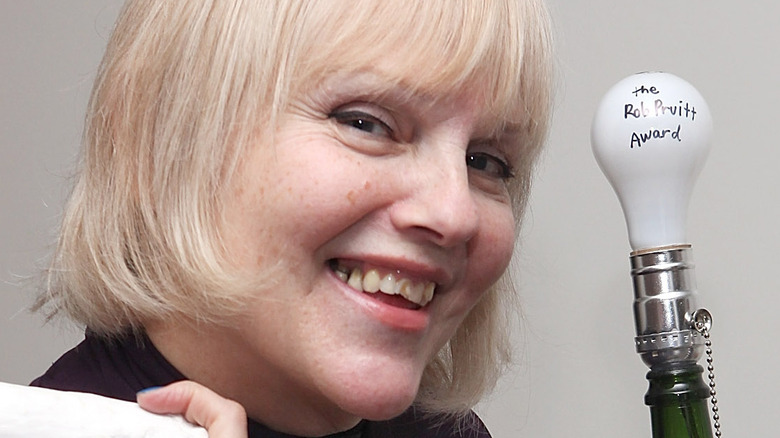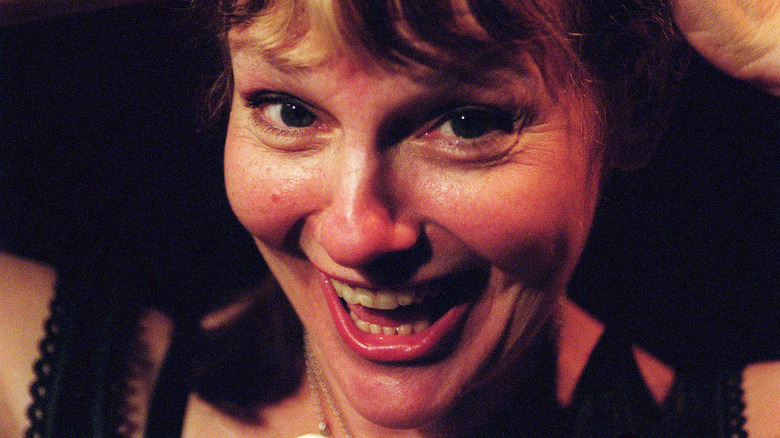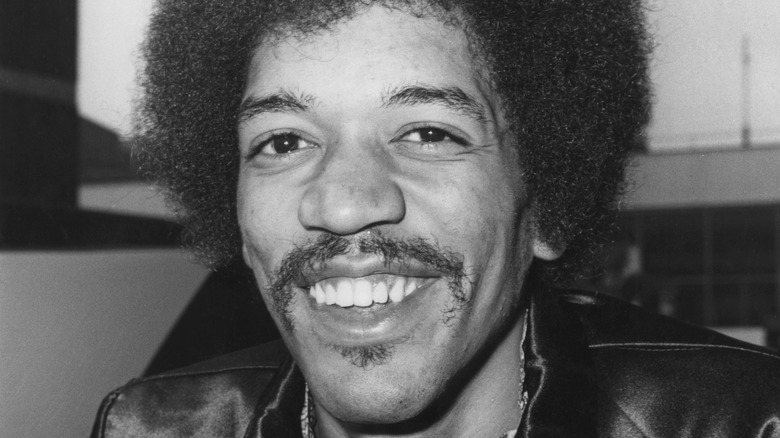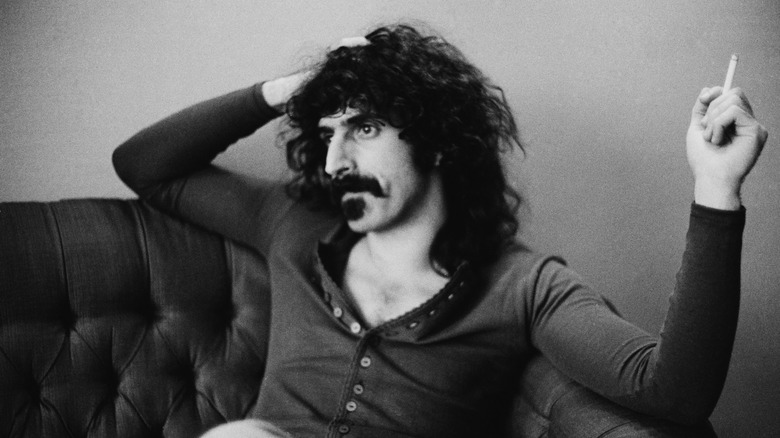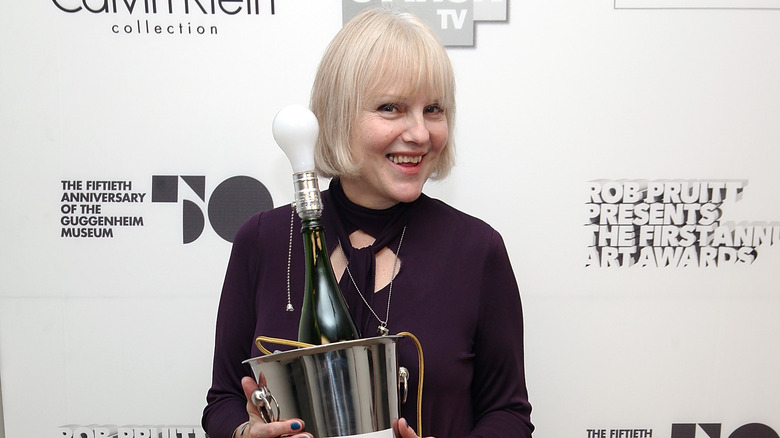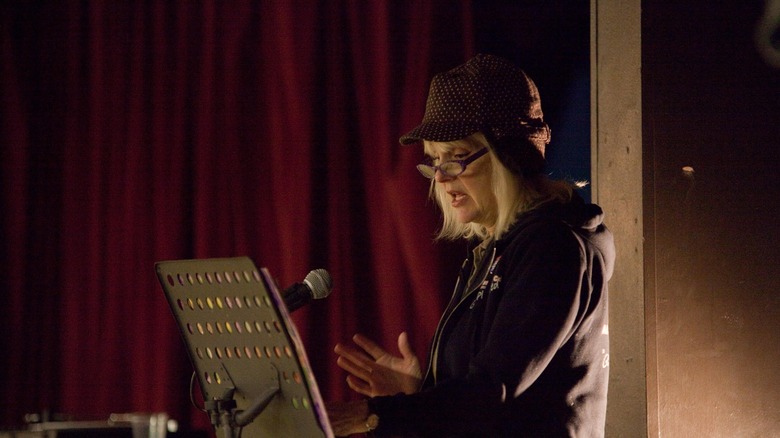How Cynthia Albritton's Art Project Led To A Career In Risqué Sculptures
On April 21, Variety announced that celebrated artist Cynthia Albritton had died at the age of 74. According to The New York Times, the cause of death was cerebrovascular disease. Born in 1947, The Los Angeles Times writes that the Chicago native was secretive about her personal and private life. Albritton, otherwise known as Cynthia Plaster Caster, became an icon when she began to make plaster molds of rock stars' genitalia in the late 1960s (via The Guardian). Ultimately, she made 50 molds throughout her career and stated that she didn't have a favorite; she loved each and every one of them.
It's known that she was an only child and that she kept her peculiar profession a secret from her mother for years. As a teen, Albritton became enamored by rock music and musicians. As she explained, "I wanted to fall in love with a British rock star." NME reports that she enrolled in art school in the 1960s. While a student at the University of Illinois, she was told to plaster an object of her choice for an assignment. It's then that Albritton decided to fuse her homework and her desire to meet rock stars into one package.
Cynthia Albritton's transformation into Cynthia Plaster Caster
The Guardian writes that Albritton's professor explained that plaster could be used to mold anything solid that could "retain its shape." Her first thought was: Why not an erect penis? Per The New York Times, Albritton first practiced her molding process on friends before making the decision to move on to famed musicians. The New York Post reports that she created a kit of sorts to conveniently take her supplies with her on the go. Albritton's process involved using a material called alginate, which was used to make dental molds. She would take the erect penis and place it in the mold.
The Los Angeles Times explains that once the member became flaccid, she would take it out and fill the rest of the mold with plaster. Albritton's creation was then complete. Some of her most well known molds include Wayne Kramer from MC5, Eric Burdon from the Animals, Jon Langford from The Mekons, and more (via Book Club Chicago).
Those who knew and encountered Albritton noted that she was incredibly shy. Nonetheless, she took her newfound career in stride. What Albritton first conceived as a ruse to bed rock stars quickly became a passion. She stated, "Only by accident did it become an art form. I take it seriously, though there is an absurd side. But I'm laughing with them, not at them" (per The New York Times).
Jimi Hendrix helped launch her career
Per The Guardian, Albritton was only 19 years old when she and her friend Diane (who dropped out of the venture soon after) coined themselves "the Plaster Casters of Chicago" and set out to create the now-iconic molds. The New York Times states that she lived at the right place at the right time; Chicago in the 1960s was a frequent tour stop for big bands. With her kit in hand, Albritton would arrive backstage and create the molds (per The Los Angeles Times). Perhaps her most famous creation is her first. After practicing on her male friends, Albritton's next mold was none other than Jimi Hendrix.
According to the New York Post, she met him at the Chicago Hilton and Towers in 1968. Albritton went on to refer to him as a "casting dream." Despite Hendrix's pubic hair getting stuck in the mold, she noted that "he didn't freak out at all. Just ... waited for me to pull out one pube at a time" (per The Los Angeles Times).
In a 2010 documentary titled "Let's Spend the Night Together" she reiterated this sentiment and described him as calm and level-headed. Albritton also made a mold of Hendrix's fellow band member, Noel Redding. Book Club Chicago writes that working with Hendrix instantly brought her notoriety and she quickly caught the attention of the man who would become her confidante, Frank Zappa (via The New York Times)
Cynthia Albritton's friendship with Frank Zappa
According to the The New York Times, famed musician Frank Zappa became a fan and champion of Albritton's work. Although he declined having his own mold made, the Los Angeles Times writes that he did financially back Albritton's eventual (but brief) move from Chicago to Los Angeles. She went on to say that Zappa's support for her was everything. Albritton explained that "He was the first person in the world to tell me I was an artist." Per The Guardian, Zappa was determined to create an exhibit with Albritton's molds but that never occurred. The Chicago Reader reports that she stopped molding in 1971.
Shortly after, Albritton's apartment was broken into (via NME). She subsequently handed her molds over to Herb Cohen, Zappa's manager, for safekeeping. However, Cohen later refused to give the phallic molds back to Albritton. As a result, she sued him in 1993 after Zappa's death. Albritton ended up getting all but three of her molds back. Despite this, she only had good things to say about Zappa. Albritton explained, "Frank was just the most important person in my life, my mentor and my supporter and my dear friend and shoulder to cry on."
She was never ashamed of her art
Despite the term "groupie" having a negative connotation, The Guardian writes that Albritton didn't mind being called one. If anything, this meant that she had been cemented in rock history. Although her art was seen as vulgar by many, Book Club Chicago explains that for her, it was all about her love for music and less about sex. Jon Langford of The Mekons (who Albritton made a mold of) agreed and said that "First and foremost, she was a music fan, and her fandom created this brilliant experimental art project."
Per the Chicago Reader, Albritton did not appreciate her art being referred to as "sex objects" because to her, they were much more than that. In her eyes, the molds helped normalize rock stars who were viewed by some as god-like (per InsideHook). Famed groupie Pamela Des Barres later said, "What Cynthia did is as much a part of rock lore as what any record producer or engineer or manager did" (via the Los Angeles Times). Des Barres added that Albritton's molds would forever be a part of pop culture.
Albritton never considered herself a feminist and stated that she never saw the molding process as "an empowerment thing." Despite this, the New York Post reports that feminists have continued to applaud her work as they feel like Albritton took control and made her art on her own terms.
Cynthia Albritton's other career moves
The Los Angeles Times reports that Albritton began making molds again in the 1980s. However, she didn't pick just anyone. She explained that "In my mind, they have to be superheroic and talented. Not just musical. I have a soft spot for artists in general." According to NME, Albritton finally had her first exhibit in New York in 2000. In 2001, a documentary titled "Plaster Caster" about the artist was released (via The New York Times). Albritton also began making plaster molds of breasts. According to Variety, her female subjects included musicians Peaches and Karen O of the Yeah Yeah Yeahs. People writes that although she never made a mold of any of the band members from Kiss they did write a song about Albritton called "Plaster Caster" in 1977.
Per the Chicago Reader, Albritton ran for mayor of Chicago in 2010. Albritton later created the Cynthia P Caster Foundation to raise money for struggling artists. With news of her death, her friend Julie Pomerleau expressed that "She was Chicago, and she was ours in a very special way." The New York Times stated that Cynthia Albritton did not leave behind any survivors.
